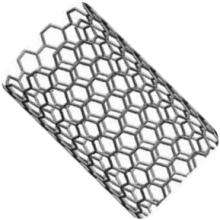Using photoluminescent probes, researchers have devised a sensitive and selective way of detecting carbon nanotubes. Innovations in energy and electronics, together with traditional reinforcement composite products, will require mass production of carbon nanotubes exceeding 15 thousand tons by 2020 (or 10 thousand tons by 2018). Mass production makes this material a potential environmental pollutant during the fabrication process, and through use and disposal. Additionally, there is some evidence that carbon nanotubes may be toxic, making it important to develop a sensitive means for detecting them in the environment.
Now, Alex Rozhin team from Aston University in the U.K. and collaborators have developed an efficient method for detecting carbon nanotubes that involves amplifying their photoluminescent signal through the formation of organic complexes with tailorable polymethine dyes. They discovered that the photoluminescent excitation of this dye is transferred to the nanotubes, strongly amplifying light emission by up to six times. Furthermore, this amplification is sensitive to both nanotube chirality and the surfactant that the nanotubes are dispersed in.
Polymethine dyes are quite versatile, demonstrating polymethine chain elongation and receptivity to various anions/cations to neutralize the charged dyes. Industry can exploit the easy tailoring of the molecular structures of polymethine dyes, which offers excellent prospects for the optimization of the chemical and physical properties of complexes of nanotubes and organic dyes with tunable optical properties. Such dyes offer great potential for chemical sensing and other photonic applications.
More information:
Carbon Nanotubes (CNT) Market Analysis By Product (Single Walled Carbon Nanotubes (SWCNT), Multi Walled Carbon Nanotubes (MWCNT)), By Application (Polymers, Energy, Electrical & Electronics) And Segment Forecasts To 2022
Published: April 2015 | ISBN Code: 978-1-68038-393-5. www.grandviewresearch.com/indu … nanotubes-cnt-market
Lutsyk P, Arif R, Hruby J, Bukivskyi A, Vinijchuk O, Shandura M, Yakubovskyi V,. Kovtun Yu, Rance GA, Fay M, Piryatinski Y, Kachkovsky O, Verbitsky A, Rozhin A. A sensing Mechanism for the Detection of Carbon Nanotubes Using Selective Photoluminescent Probes Based on Ionic Complexes with Organic Dyes. Light: Science & Applications 2016; 5: e16028. DOI: 10.1038/lsa.2016.28
Provided by Aston University























